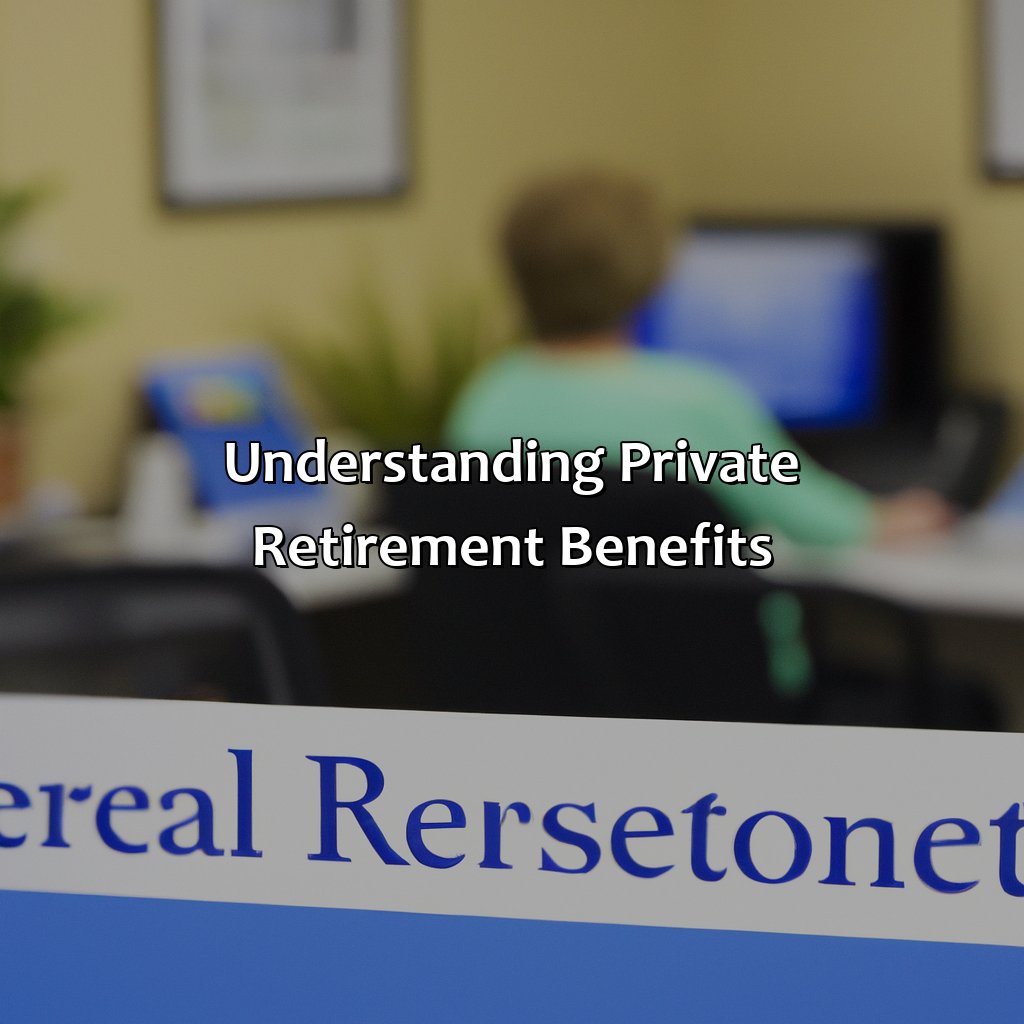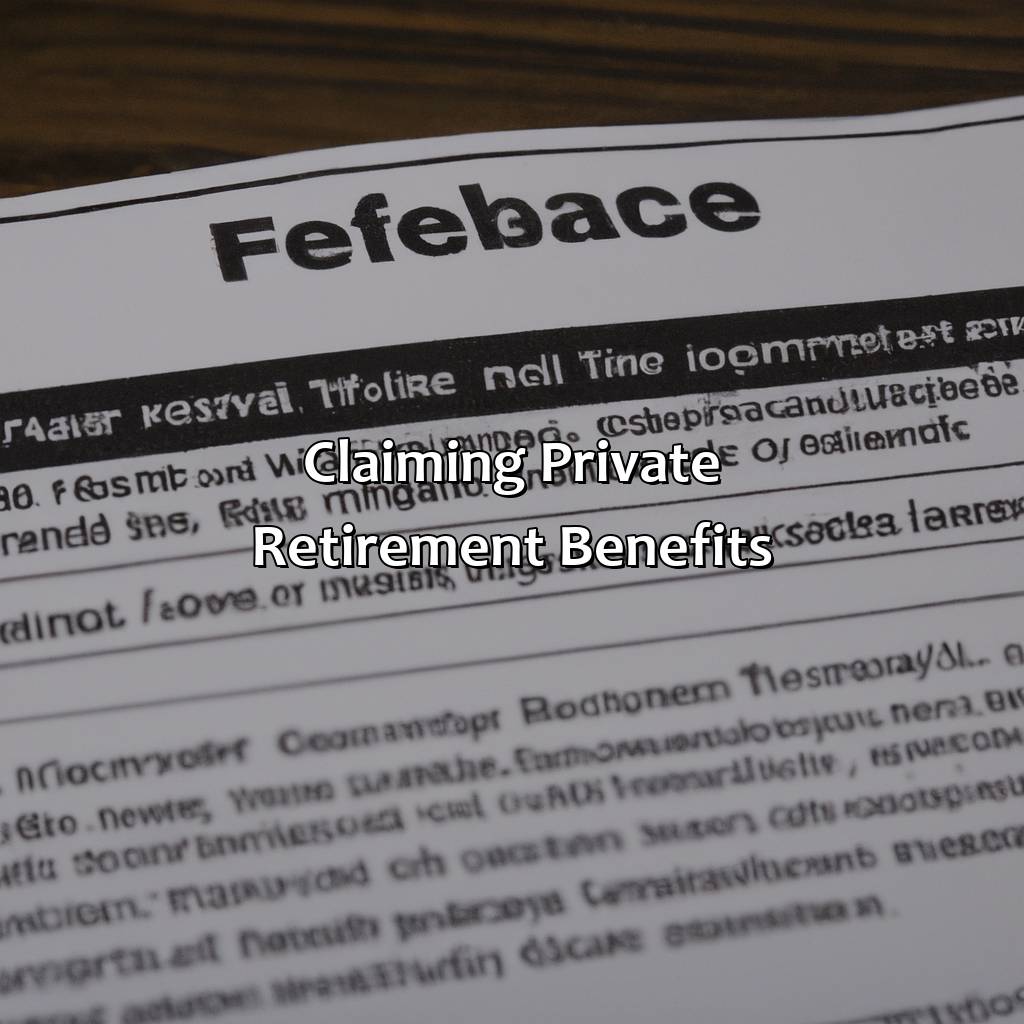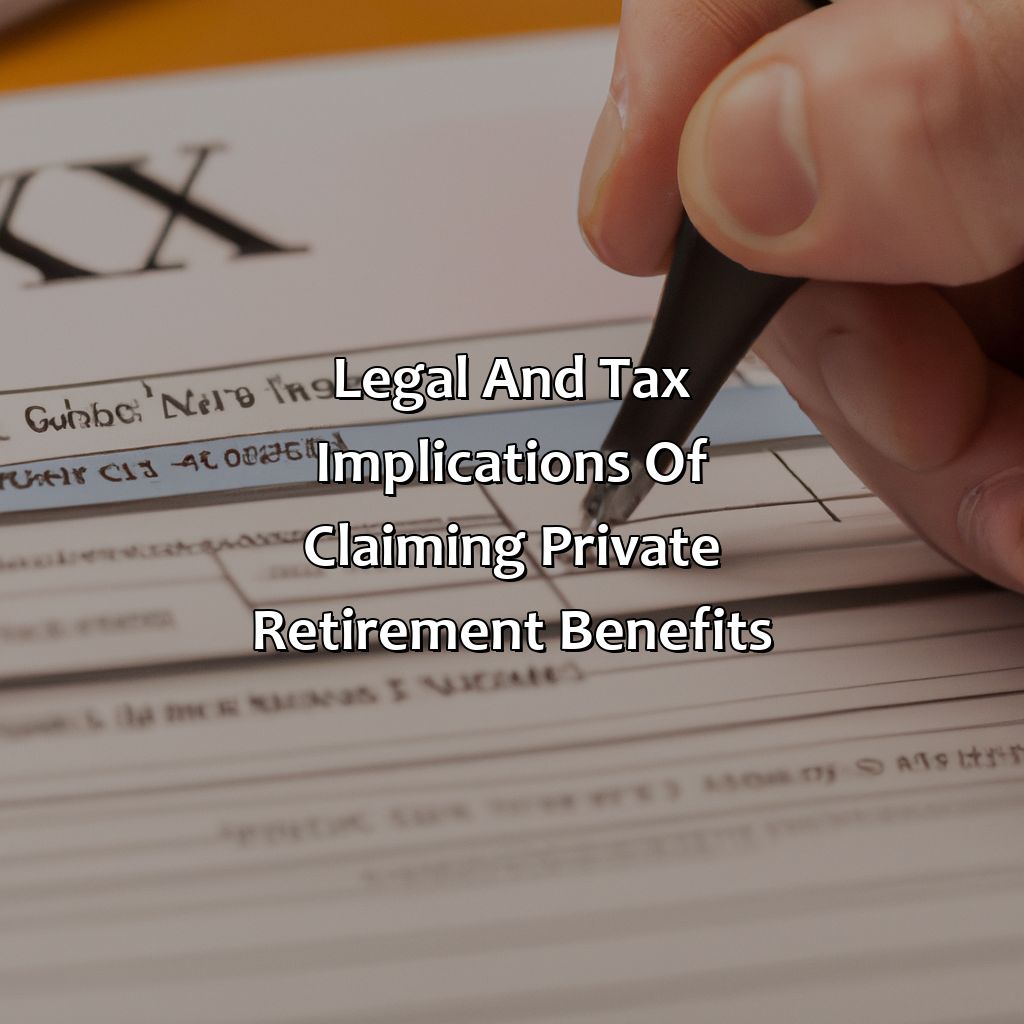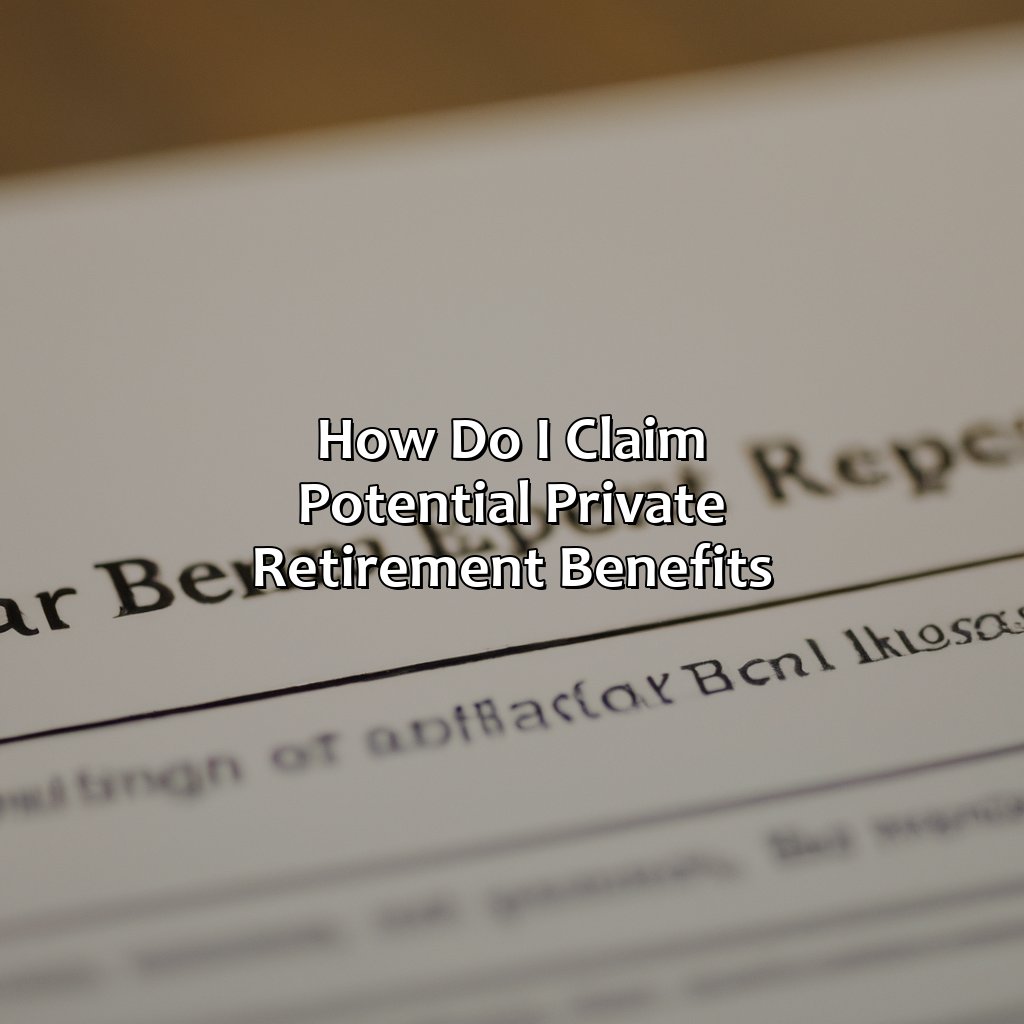How Do I Claim Potential Private Retirement Benefits?
Key Takeaway:
- Private retirement benefits refer to retirement savings plans that are established by employers or individuals, such as 401(k)s, IRAs, and pensions. Understanding the types of private retirement benefits available and your eligibility for them is crucial in order to claim your benefits successfully.
- Documentation required for claiming private retirement benefits varies depending on the type of plan you have. It is important to gather all necessary documentation, such as government-issued identification and proof of ownership of the account, before starting the claims process.
- When claiming private retirement benefits, it is important to follow the specific steps outlined by your plan. Some plans may require you to contact your employer or financial institution, while others may allow you to initiate the process online. Make sure you understand the process and requirements in order to avoid delays or errors in receiving your benefits.
Are you worried about how to secure your retirement benefits? Discover how to access the potential benefits from your private pension plan with this comprehensive guide. You’ll learn how to claim the benefits you are entitled to.
Understanding Private Retirement Benefits
Do you want to know about private retirement benefits? If so, you need to learn the different types and see if you meet the eligibility requirements. Hence, this guide ‘Understanding Private Retirement Benefits‘ is here. It breaks down into two sections – ‘Types of Private Retirement Benefits‘ and ‘Eligibility for Private Retirement Benefits‘. These can help you make decisions about your retirement plan with peace of mind.

Image credits: retiregenz.com by Adam Woodhock
Types of Private Retirement Benefits
Private Retirement Benefits Explained
Private retirement benefits vary and can be claimed by eligible individuals. These benefits include pensions, annuities, employer-sponsored retirement plans, and private retirement savings accounts.
The following are the types of private retirement benefits:
- Pensions: This is a type of retirement benefit offered by employers to their employees. It provides regular income payments to retirees.
- Annuities: This is an insurance product that can provide regular income in exchange for a lump sum payment.
- Employer-Sponsored Retirement Plans: These are retirement plans established and maintained by employers for the benefit of their employees.
- Private Retirement Savings Accounts: These are individual savings accounts created by eligible individuals to save for their retirement.
Remember that each private retirement benefit has unique features and eligibility requirements. Understanding the terms associated with each one will help you make an informed decision when claiming them.
It’s worth noting that private retirement benefits have played a significant role in helping retirees maintain financial well-being during their golden years. For example, pensions have been around since the 17th century, with the first pension plan being introduced in 1875 by the American Express Company. Over time, these plans have evolved and helped millions of Americans achieve a secure retirement.
Don’t worry, if you’re ineligible for private retirement benefits, you can always retire to your couch and binge-watch Netflix instead.
Eligibility for Private Retirement Benefits
Private Retirement Benefit Entitlements
To claim potential retirement benefits from private sources, it is imperative to understand the eligibility criteria. The entitlement process involves establishing eligibility through age, years of service, or meeting specific pension requirements.
Several factors may affect an individual’s entitlement to private retirement benefits. These could include the type of industry, company policy, or state statutes. One could be eligible for a defined benefit plan that provides financial security for life after meeting specific criteria such as tenure or company contributions.
Moreover, qualifying for private retirement benefits could depend on various internal and external factors such as employee work history and tax status. Individuals are encouraged to keep track of their employment history and maintain a comprehensive record of related documents to assist in calculating future income.
A well-known real-life example is a pension scheme offered by companies that provide defined-benefit plans based on employee contributions or length of time served.
Retirement benefits: the only thing better than getting paid to work is getting paid not to work.
Claiming Private Retirement Benefits
We’ll explain everything in two sub-sections:
- ‘Documentation Required for Claiming Benefits’
- ‘Steps to Claim your Private Retirement Benefits’
Get ready to learn all about claiming your private retirement benefits!

Image credits: retiregenz.com by David Duncun
Documentation Required for Claiming Benefits
When making a claim for private retirement benefits, it is important to have all the necessary documents ready. The following are some of the necessary documents required:
- Proof of identity – This could be a social security card, driver’s license or passport.
- Employment history – Provides information such as employer name and address, dates of employment and job title.
- Proof of earnings/documents showing income – Could include tax returns or W-2 forms from previous employers.
It is essential to gather all this information before submitting any claims. A thorough review of relevant materials can aid in preventing unnecessary delays, as presenting insufficient documentation may result in rejection.
To ensure expedited payment, keep track of the deadlines pertaining to specific claims. Failure to submit a qualified application on time may cause forfeiture of benefits.
There are several ways an individual can assist with gathering necessary documents. Seeking assistance from a qualified financial advisor or using software that monitors their progress towards securing retirement payouts sometimes facilitate efficient collection and management.
Taking proactive measures can help facilitate claiming ongoing retirement payments from private sources efficiently. Therefore, use these tips for procuring early payouts by remaining vigilant about your responsible (fiscal) processes.
Retirement benefits are like free money, except someone else got to use it first.
Steps to Claim your Private Retirement Benefits
To ensure you receive your retirement benefits, follow these steps to claim your personal pension:
- Collect your plan documents and know the eligibility criteria and payment terms.
- Contact the employer who sponsored the plan to obtain required forms for filing.
- Fill out all necessary forms with accurate information and attach appropriate documents.
- Submit all forms to the designated employee benefits or human resources department of your former employer.
- Wait for confirmation with details on how, when and in what form payments will be made.
It is worth noting that by not claiming private retirement benefits, you may be missing out on a sizeable amount of money. Every year it stays unclaimed means additional lost income during retirement. Don’t let fear of complications deter you from submitting a claim now. It’s a small effort for potentially significant payback in the long run.
Claiming private retirement benefits may boost your bank account, but beware the legal and tax implications that could leave you with less than you thought.
Legal and Tax Implications of Claiming Private Retirement Benefits
Private Retirement Benefits: Legal and Tax Implications
Claiming private retirement benefits involves legal and tax implications. These implications vary depending on the type of plan and the specific circumstances of the beneficiary. It is vital to understand these implications to avoid potential legal and tax issues.
When claiming private retirement benefits, it is necessary to consider the laws governing the plan and the taxes that apply. Some plans may have strict rules for distributing benefits, while others may not. Furthermore, taxes on the benefits could vary according to the state and federal laws of the beneficiary.
In addition to the legal and tax implications, beneficiaries should also weigh their options carefully. They could claim the benefits as a lump sum or periodically over time. Moreover, they should ensure that they meet all eligibility criteria for the plan before making any claims.
A retiree, John, claimed his private retirement benefits without considering the legal and tax implications. As a result, he had to pay more taxes than he expected, causing a strain on his finances. John learned the hard way that claiming retirement benefits without proper planning could lead to financial difficulties.
In summary, claiming private retirement benefits requires careful consideration of legal and tax implications. Beneficiaries should take the necessary steps to understand the laws governing the plan and the applicable taxes. Planning accordingly could help avoid potential legal and tax issues.

Image credits: retiregenz.com by James Woodhock
Some Facts About How To Claim Potential Private Retirement Benefits:
- ✅ Private retirement benefits are typically offered through an employer-sponsored plan or an individual retirement account (IRA). (Source: NerdWallet)
- ✅ To claim potential private retirement benefits, you may need to contact your former employer or the financial institution managing your IRA. (Source: U.S. Department of Labor)
- ✅ It’s important to keep track of your retirement accounts and ensure you’re claiming all potential benefits you may be entitled to. (Source: The Motley Fool)
- ✅ The process for claiming private retirement benefits may vary depending on the specific plan or account. (Source: Investopedia)
- ✅ Failing to claim potential private retirement benefits could result in lost income during retirement. (Source: CNBC)
FAQs about How Do I Claim Potential Private Retirement Benefits?
How do I claim potential private retirement benefits?
To claim potential private retirement benefits, you need to determine the retirement benefits you’re eligible for, contact the retirement plan’s administrator, and submit your claim. Here are the steps you should take:
- Determine the benefits you’re eligible for: The first step is to find out the types of retirement benefits you’re eligible for.
- Contact the retirement plan’s administrator: The next step is to contact the administrator of the retirement plan you’re eligible for and request a claim form.
- Complete and submit the claim form: Fill out the claim form provided by the administrator carefully and submit it to the retirement plan’s administrator.
- Provide any supporting documents: You may need to provide additional documentation to support your claim, such as proof of your identity, age, employment status, and other relevant details. Make sure you provide all the necessary documents.
- Wait for the claim to be processed: Once you’ve submitted your claim, it may take some time for the administrator to process it and determine your eligibility for retirement benefits. You’ll receive a response from the retirement plan’s administrator once your claim has been processed.
Can I claim private retirement benefits if I have never worked?
If you’ve never worked, it’s unlikely that you’ll be eligible for private retirement benefits. Most retirement plans require you to have worked and made contributions to the plan to be eligible for benefits. However, if you’re a dependent or surviving spouse of someone who has worked and made contributions to a retirement plan, you may be eligible to claim benefits.
What happens if my claim for private retirement benefits is denied?
If your claim for private retirement benefits is denied, you may have the option to appeal the decision. You should review the retirement plan’s appeal process and follow the steps necessary to appeal the decision. Alternatively, you may want to seek the advice of an attorney who specializes in retirement benefits law to help you with the appeal process.
How much private retirement benefits can I claim?
The amount of private retirement benefits you can claim will depend on the retirement plan you’re eligible for and the amount of contributions you’ve made to the plan. Different retirement plans have different benefits structures, and some may offer higher benefits than others. You should review the plan’s benefits information and consult with a financial advisor to determine the potential benefits you may be able to claim.
When can I start claiming private retirement benefits?
The age at which you can start claiming private retirement benefits will depend on the retirement plan you’re eligible for. Some plans allow you to start claiming benefits as early as age 55, while others may require you to wait until you’re 65 or older. You should review the plan’s benefits information and eligibility requirements to determine when you can start claiming benefits.
What happens to my private retirement benefits if the retirement plan’s administrator files bankruptcy?
If the retirement plan’s administrator files bankruptcy, your retirement benefits may be at risk. However, there are federal and state laws that protect retirement plans and ensure that participants are paid the benefits they’re entitled to. In the event that the retirement plan’s administrator files for bankruptcy, you should contact the Employee Benefits Security Administration (EBSA) to determine your rights and options.






